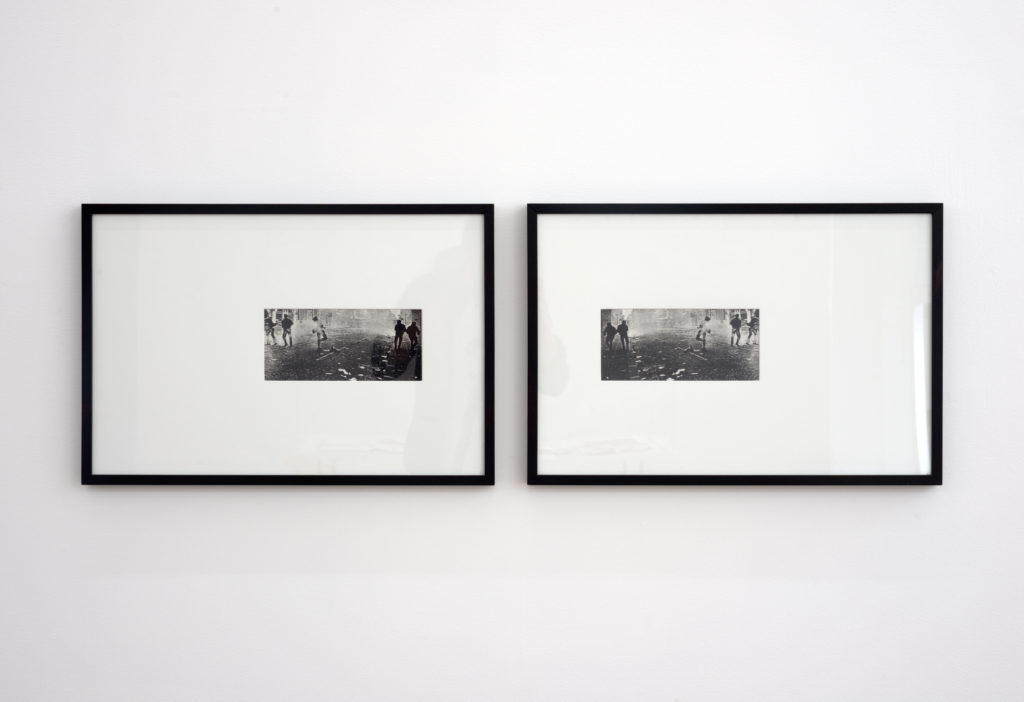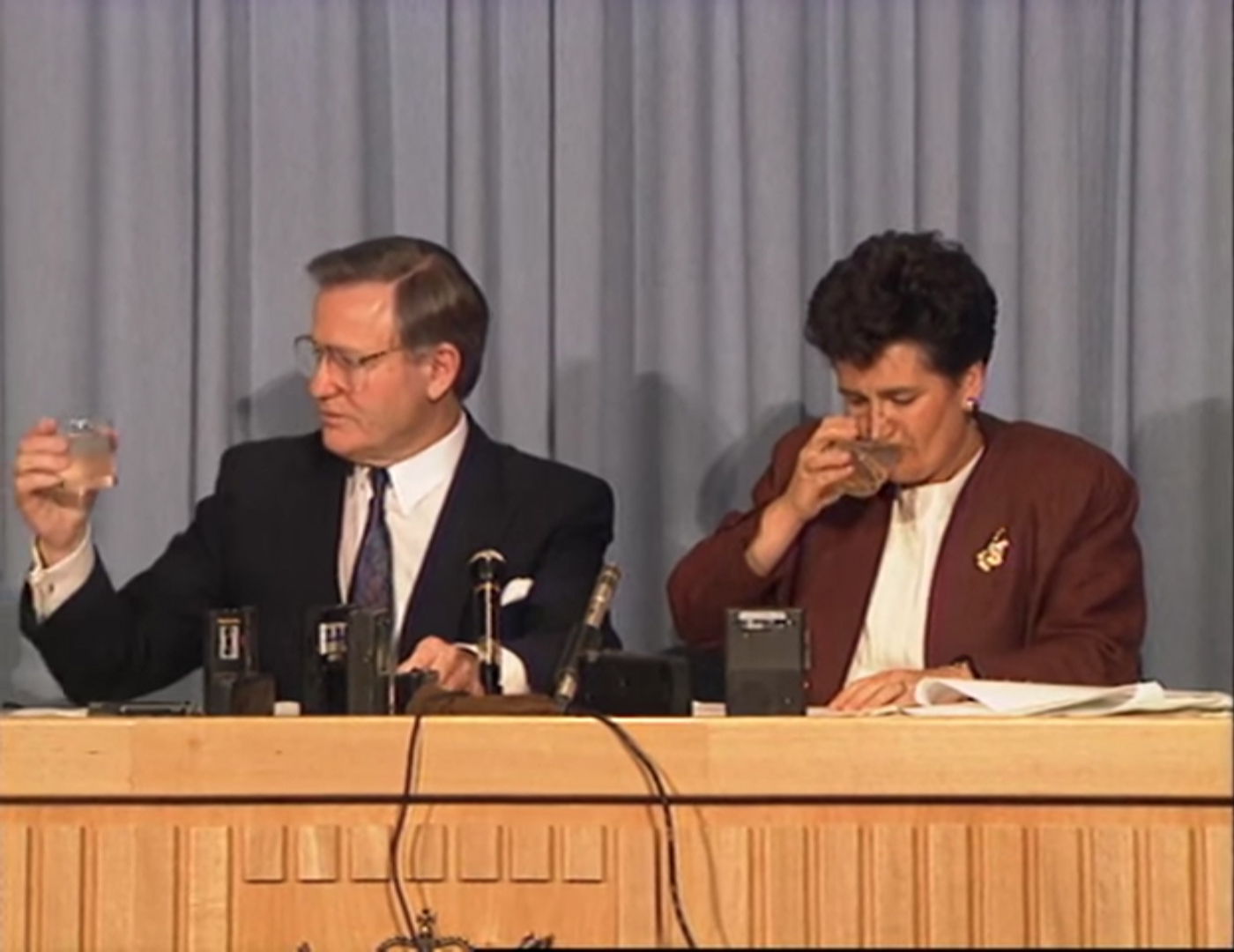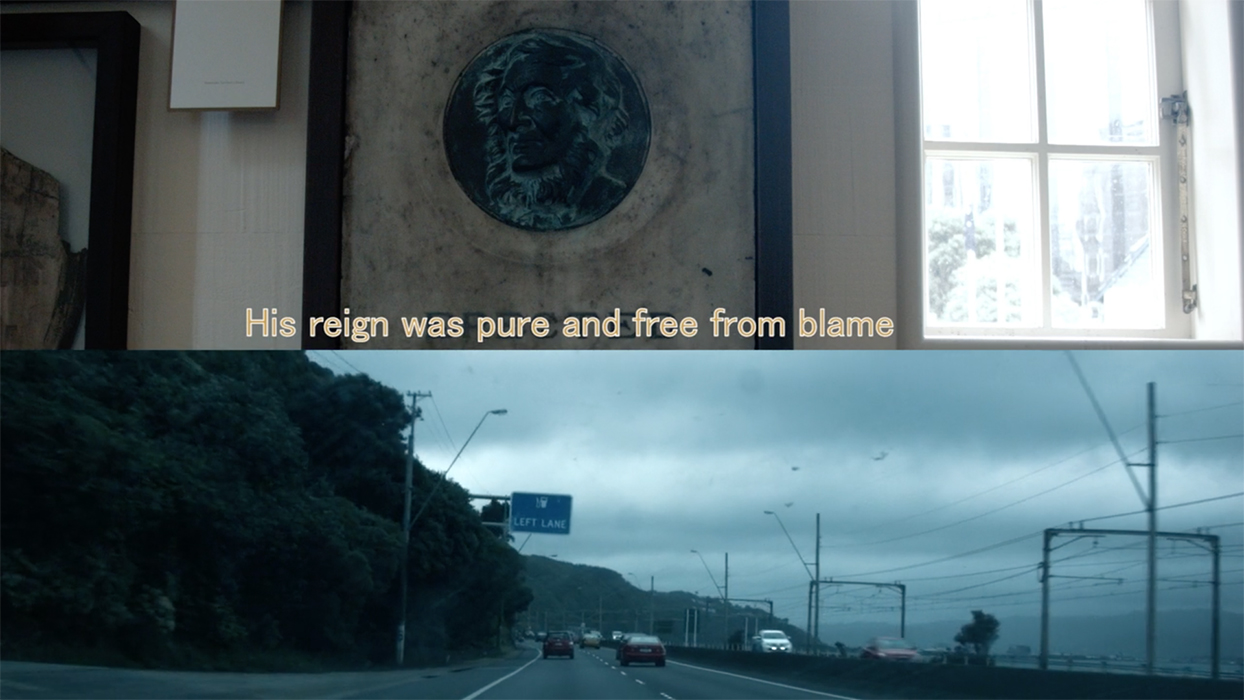

Notes
1Between July 2015 and August 2018, the author was employed by City Gallery Wellington Te Whare Toi as a visitor services host.
2“Iconography of Revolt,” City Gallery Wellington, accessed September 20, 2018, https://citygallery.org.nz/exhibitions/
iconography-of-revolt.
3Robert Leonard and Anna-Marie White discuss Hubbard’s curatorial career in the ’80s and ’90s in the recently published essay, “George Hubbard: The Hand that Rocked the Cradle,” Reading Room 8 (2018): 30–67; Anna-Marie White and Robert Leonard, conversation with the author, Wellington, October 25, 2018.
4Peter Brunt, “Since ‘Choice!’: Exhibiting the ‘New Māori Art’,” in On Display: New Essays in Cultural Studies, ed. Anna Smith and Lydia Weavers (Wellington: Victoria University Press, 2004); Evan Te Ahu Poata-Smith, “He Pokeke Uenuku i Tu Ai: The Evolution of Contemporary Māori Protest,” in Nga Patai: Racism and Ethnic Relations in Aotearoa New Zealand, ed. Cluny Macpherson, Davis Pearson and Paul Spoonley (Palmerston North: Dunmore Press 1996); Ranginui Walker, Ka Whakai Tonu Matou: Struggle Without End (1990; repr., Auckland: Penguin, 2004).
5George Hubbard, Stop Making Sense: Who’s Pushing the Bandwagon Anyway, 1996, accessed September 20, 2018 via “Stop Making Sense: Documents,” City Gallery Wellington, https://citygallery.org.nz/documents/
stop-making-sense-documents.
6McKenzie Wark, The Beach Beneath the Street: The Everyday Life and Glorious Times of the Situationist International (London: Verso, 2011), 155.
7Verso’s series of blog posts on the May ’68 riots provide a comprehensive overview of contemporary reflections on the event. “Archive of 1968,” Verso, accessed October 28, 2018, https://www.versobooks.com/blogs?tag=310.
8Russell Campbell, “The New Right and Documentary Film in New Zealand: Someone Else’s Country & Revolution,” Illusions 34 (Winter 2002): 3.
9Someone Else’s Country, directed by Alister Barry (Wellington: Community Media Trust, 1996), mp4, 104:00, NZ On Screen, accessed November 8, 2018, https://www.nzonscreen.com/title/someone
-elses-country-1996/overview.
10Paul Maunder, Vanguard Films: A Better World is Possible (Wellington: Ngā Taonga Sound and Vision, 2010).
11Erika Balson, “The Reality Based Community,” e-flux 83 (June 2017), accessed November 21, 2018, https://www.e-flux.com/journal/83/142332/
the-reality-based-community.
12Lauren Berlant, Cruel Optimism (Durham: Duke University Press, 2011), 238.
13Berlant, Cruel Optimism, 3–7.
14Berlant, “The Commons: Infrastructures for Troubling Times,” Society and Space 34, no. 3 (2016): 394.
15Berlant, Cruel Optimism, 252.
16Matilda Fraser, Workin’ Nine to Five, What a Way to Make a Livin’, published alongside The Tomorrow People, Adam Art Gallery, 2017; Matilda Fraser, conversation with the author, Wellington, October 26, 2018.
17Henry Cooke, “Jacinda Ardern says Neoliberalism has Failed,” Stuff, September 12, 2017, accessed October 27, 2018, https://www.stuff.co.nz/national/politics/96739673/
jacinda-ardern-says-neoliberalism-has-failed.
Upon return
My first essay for Extended Conversations circulated around the question of commitment. It asked, broadly, what keeps us attached to art—knowing its transformative potential may be limited? In response, it offered an affirmation, of sorts, of art’s capacity to intervene in common sense understandings of the world, and to reimagine the past, present and future. A yearlong project such as this one allows for lateral thinking. It allows for lines of thought to be followed into unexpected terrain, for questions to be reformulated or for answers to fold back in on themselves. In this second essay, the question of commitment becomes more closely aligned with ambivalence. It tracks three moments in the recent history of Aotearoa, focussing on three works made within the context of the rapid economic restructuring of the state, the erosion of workers’ rights and the consequences of capital’s increasing financialisation. Alongside the economic restructuring of the state, there has been a sustained reconsideration of Aotearoa’s colonial history and attempts to redress some of its worst injustices. The first part examines Giovanni Intra and Michael Parekōwhai’s 14 May 1968 (1995), which recently featured in the exhibition Iconography of Revolt at City Gallery Te Whare Toi. The second jumps back, away from Iconography of Revolt, to Alister Barry’s documentary Someone Else’s Country, originally released in 1996. The third looks at Matilda Fraser’s work The Eight Hours Plan (2017). This essay does not provide a history of the past three decades; its scope is far too limited for that. Rather, it thinks through, briefly, how these political and cultural shifts have crystalised in these works, and how the ambivalent position they take up, in different ways and to different extents, might be a means to trace the changing contours of a political landscape whose shape, texture and magnitude cannot yet be known.

Giovanni Intra and Michael Parekōwhai, 14 May 1968, 1995, framed photographs. Image courtesy of Michael Parekōwhai, the Giovanni Intra estate, Michael Lett and Alex North.
1968/1995
The gesture is heroic, but its scale is diminutive. It’s a money shot, if you will; a figure, clouded by smoke, hurls a projectile towards an unseen combatant. Other more shadowy figures flank the thrower on either side, some advancing, some retreating. The moment depicted took place in Paris on May 14, 1968, in the middle of riots that would radically alter the trajectory of the organised Left for the remainder of the 20th century. It was a moment of coalition between students and workers that, ever so briefly, brought the French state to its knees.
Beside the image, in a separate frame, is its mirror. Together, the framed images make up 14 May 1968 (1995), a work by Giovanni Intra and Michael Parekōwhai, recently included in Iconography of Revolt at City Gallery Wellington Te Whare Toi (July 28 to November 18, 2018), curated by Robert Leonard.1 It was lost in the exhibition. The work was hung on an almost empty wall in an almost empty gallery. It was directly opposite Marco Fusinato’s monumental The Infinitive 5 (2015), which, again, depicts the moment just before a protestor hurls an object (the identity of the protestor and the specific circumstances of their protest remain unknown to us), only this time the image is rendered as if it were a history painting.
Iconography of Revolt was full of these decisive moments, of collective complaint taken to the streets, met with violence, captured, circulated and eventually tamed, reified into objects of contemplation. The exhibition’s aim, according to the gallery’s website, was to “showcase some of the ways revolt and revolution, protest and insurrection, have been pictured in art, film, and elsewhere.”2 It was an exercise in formalism, then, and appeared to abdicate itself of any discernible position. The show picked up relics from across the last century, from varied movements, from varied places. Certain gestures, poses and slogans repeat themselves. Objects, images and costumes, which first appeared on the barricades, find themselves repurposed into advertising campaigns, fashion editorials, movie trailers. In appearing to avoid a position, the exhibition seemed to lodge a melancholic one. In the present, all icons of protest are used up, liable to be recaptured by the very machinery they wish to overthrow. It’s melancholic, perhaps, but not entirely defeatist. There were moments in the exhibition that cast the political as a field of ambivalence, allowing artists to play with signs of struggle, and play upon the slipperiness of meaning, to use this very slipperiness as a means to consider how terms of engagement in the political contemporary seem difficult to pin down.
Nothing is said of 14 May 1968’s original context. The work first appeared at City Gallery twenty-three years ago, in the exhibition Stop Making Sense, curated by George Hubbard. For Stop Making Sense, Hubbard paired fifteen Māori and fifteen Pākehā artists, asking them to produce a collaborative work. Some of the pairings were fruitful, others awkward. Diane Prince was paired with Terrence Handscomb. In response to signs produced by Handscomb declaring, “Ethnically challenged white NZ Male/seeks/PC sensitive dominatrix/to support culture punishment game,” Prince arranged a table with faces baked into parāoa, producing her own sign reading, “Freshly Baked Phoney Hone Paraoa 50c.”3 Chris Heaphy was paired with Gordon Walters. In their paintings, Walters—canonised in Aotearoa’s art history for his hard-edged appropriations of kōru—reproduced these icons in miniature. Heaphy added his own array of symbols painting over and around Walters’ markings.
Where most works in Stop Making Sense bear the traces of each artist’s signature—and it’s easy to read the works as composites of two distinct practices—authorship is left murky in Intra and Parekōwhai’s work. It’s autobiographical, sort of. Parekōwhai was born on May 13, 1969, and Intra on May 15, 1968. But the work also points outside the local context of bicultural policy—the triumphalism of its rhetoric and its failures to bring about meaningful equality—that Hubbard’s curatorial conceit played upon. As Ranginui Walker, Evan Te Ahu Poata-Smith, Peter Brunt and others have pointed out, the trajectory of Aotearoa’s bicultural policy occurred in parallel with the New Right revolution of the 1980s and early 1990s—which gutted the Welfare State, compromised trade unions’ ability to collectively bargain for better working conditions, massively reduced tariffs and trading regulations and transformed the state sector into bodies resembling private corporations, driven exclusively by maximising profit.4 Hubbard alludes to this ambivalent legacy in his brief curatorial essay, referring to the fiscal limit set on Treaty of Waitangi claims by the Fourth National Government in 1994. “Some will think that Stop Making Sense is a promotional tool for the outdated notion of biculturalism—it is not! With the fiscal-envelope fiasco I would prefer to think of Māori as cross cultural (cross and cultural), and not bicultural.”5
But why Paris? The Paris riots hold an outsized influence. In part, because the event belongs to a series of ruptures, each with their own determining factors, that signalled the beginning of the demise of Keynesianism in the west; in art history in particular because of the event’s association (sometimes overstated) with Guy Debord and the Situationists; and in part because the event had a formative impact on a generation of French intellectuals who, since the 1980s, have been absorbed into the vernacular of both the academy and the art world. Beyond the biographical, what does the moment chosen by Intra and Parekōwhai say? What are the implications of May ’68 in Aotearoa in 1995, and again in 2018? In Iconography of Revolt, without the benefit of its provenance, the work served simply as an icon of an overdetermined moment among other moments thick with desperation, optimism and chaos. A single image of what politics is and where it happens. Which is to say, politics, according to Iconography of Revolt, happens elsewhere. Notably absent from the show were references to moments of political rupture in Aotearoa, its visual documentation, or aesthetic treatments of those moments. Aotearoa has its own iconography of political rupture, but these weren’t the ones chosen by Intra and Parekōwhai, or by Leonard.
14 May 1968 is a means for Intra and Parekōwhai to locate themselves in relation to May ’68 as a periodising event, but whether the tone of the gesture is one of tribute to the spirit of coalition, nostalgia for such a possibility or simply a postmodern appropriation of an image thick with meaning isn’t clear. What is clear is that May ’68 can’t be spoken of without conjuring the ghosts of historical failure. McKenzie Wark writes, “May ’68 did not induce the revolution so much as a whole industry of commentary. Violence is the midwife of history publishing. Enough books entered the market to rebuild all the barricades many times over.”6 This year is the 50th anniversary of the event, and with the anniversary has come a renewed interrogation of the riots; their tactics, protagonists, legacies and inheritors.7 If, in its original context, the work is a sleight of hand, an awkward transposition of an almost revolutionary moment into the middle of the neoliberal remaking of this country, then from this juncture the work seems to be about dwelling in and with these dual histories; about holding, maybe loosely, to the horizon of possibility frozen in the photograph, not necessarily to mourn or resurrect it, but to insist upon its place in the world.

Alister Barry, Someone Else's Country, 1996, film, still. Image courtesy of Alister Barry.
1984/1996
In 1996, a year after 14 May 1968 was first exhibited, Someone Else’s Country—Alister Barry’s documentary detailing the restructuring of New Zealand’s state that took place in the 1980s and early 1990s—premiered at film festivals around the country. From there, the film went on to become a leftist classic, screened by community organisers, distributed on video and later DVD and eventually screening on a music TV station.8
The film opens with archival scenes from Chile’s 1973 US-backed military coup, which unseated democratically elected socialist president Salvador Allende and eventually installed Augusto Pinochet as dictator. People in the streets chant “Create, create, create people’s power!” before the film swiftly cuts away to bomber planes flying overhead, shots of civic buildings being targeted and military tanks roaming the streets. Ian Johnstone’s sombre, measured voice is heard: “In 1973, many New Zealanders watched with concern as Chile’s new military dictatorship imposed wide-ranging social and economic changes.… Ten years later, no armed force was needed when a democratically elected government began a similar programme of change in New Zealand.”9 It’s a deeply unsettling comparison to make, not least because it risks making light of the more than 3000 Chileans who were killed or went missing under the Pinochet regime. But it also establishes a deeply unnerving contrast between these brief scenes of military brutality, and how swift and completely ordinary Aotearoa’s restructuring seems in hindsight. There was, of course, mass opposition to many of these changes. But these protests, as the film details, from Māori, trade unionists and students, were met with little more than smug dismissal.
Someone Else’s Country is social documentary in the conventional sense, placing faith in the image to act as testimony to an under-acknowledged truth about the world. This modus operandi has been adopted by Barry and Vanguard Films, the media collective with which he has been associated for four and a half decades. Paul Maunder writes that Vanguard operates by “telling a community’s stories to that community and its circles, recognising people and kings people in places and kinds of places.”10 Someone Else’s Country, necessarily, weaves a story from the events of the decade prior to its release. It begins with a model welfare state stormed by the agents of foreign capital, who quickly imposed an ideological agenda. People suffered, and those who suffered mobilised their power to reform Aotearoa’s electoral system. Interview subjects, almost uniformly opposed to neoliberal reform, share anger and a sense of injustice, but also bafflement, as if things are still coming into focus. The film, then, seems an effort to narrativise the recent past in order to make sense of it.
The film offers an openly partisan view of the political landscape within which Intra and Parekōwhai made their work, but it also offers a view of politics counter to the scenes of exception Iconography of Revolt would suggest. In Someone Else’s Country, politics and revolution take place from the safety of parliamentary chambers and glass-walled offices, and are communicated via the language of management. Those responsible for redistributing wealth are safely sheltered from the violence of their decisions, and thereby more willing to feign disbelief at the consequences of their actions.
Here, partisanship, or an unwillingness to let apologists for neoliberalism state their position beyond what has already been archived, isn’t necessarily a failure of the filmmakers to faithfully document reality, for fidelity may not have been the purpose of the film. Someone Else’s Country seeks out an audience whose horizons have been narrowed, or, as Erika Balsom would put it, calls an imaginary community into being.11 It confirms their worst fears about the state of things, insisting upon a certain truth about the world, which would be denied if the film abided by the conventional journalistic standard of presenting two visions, two sides, as if equally valid. In doing so, the film insists that the state of things may not be inevitable. The film’s mode of address, and the means by which it was distributed in the mid-1990s, is a means of binding an intimate public, allowing them, as Lauren Berlant writes, to “rehearse affectively what the world will feel like when its vision gains mass traction.”12
Watching the film in 2018, certain phrases sound familiar. Archival footage features figureheads claiming that these changes, like the worst measures implemented during the decade of austerity we’re now barely surfacing from, were “necessary.” That they provided “stability,” “opportunity,” that they enhanced efficiency. At one point, then finance minister Ruth Richardson, who instituted the second round of major restructuring in the early 1990s, is seen giving a speech to a dinner held by the Wellington Chamber of Commerce, stating, “too many New Zealanders float in a dreamworld that has the good life as a matter of right.”
Richardson, no doubt, means something specific when she announces the death of the “good life,” but her choice of words is telling. For Lauren Berlant, writing two decades later and in the United States, the good life is a commonly understood and clung to fantasy of collective thriving around which, and on behalf of which, political discourse makes its claims.13 For Berlant, the decades since the neoliberal restructuring of the state in the United States, United Kingdom, Australia, Aotearoa and elsewhere, are times of transition; times in which the state has abandoned any promise of securing widespread flourishing, thereby dramatically lessening the demands that might be made of it. One of the central questions in Berlant’s writing over the past decade is, without a tenable fantasy of a good life, how might we gather the resources to sustain an attachment to remaking the world?

Matilda Fraser, The Eight Hours Plan, 2017, digital video, still. Image courtesy of the artist.
1840/2017
One answer Berlant offers to this question is to shift our attention away from the moments of mass mobilisation, like May ’68, towards quieter moments of everyday endurance. She writes,
To attend to the terms of transition is to forge an imaginary for managing the meanwhile within damaged life’s perdurance, a meanwhile that is less an end or an ethical scene than a technical political heuristic that allows for ambivalence, distraction, antagonism and inattention not to destroy collective existence.14
Such a mode of attention can risk exalting the downtrodden for their necessary creativity in finding the means to stay afloat, and thereby risks reproducing the very conditions that called for such creative endurance in the first place. But it might also allow us to find the will to be otherwise in places that don’t initially seem obvious, and to recast the political from either a formalised process limited to rare moments of exception or periodic democratic engagement—staying attuned to parliamentary dramas, voting, protest—into something more visceral. This mode of attention makes the political, as Berlant puts it, “that which magnetizes a desire for intimacy, sociality, affective solidarity, and happiness.”15
Everyday endurance meets a will to be otherwise in Matilda Fraser’s work The Eight Hours Plan (2017), commissioned by Circuit for their public venue on Masons Lane, Te Whanganui-a-Tara. The work is part ode to Samuel Parnell, whose agitation secured the eight-hour working day for workers in Aotearoa, and part document of the comfortable monotony of the contemporary office. The video is silent, and for most its duration, the screen is split in two horizontally. On top, stationary shots of a memorial to Parnell and subtitles of a poem dedicated to him, “His home rule was to rule the time, for us to work and rest, to give fair play to every clime, to all with toil oppressed.” Below, we follow cars along the motorway between Wellington and the Hutt Valley, glimpse shots of hands typing at a keyboard. We see a messy archive with boxes stacked precariously above drawers, the corner of a break room decorated with a tinsel sign bearing the words “It’s never too soon to quit.”
Parnell’s story begins in 1840. After being approached by shipping agent George Hunter to build a shop, Parnell agreed, on the condition he only work eight hours each day. A severe labour shortage in the nascent colony forced Hunter to acquiesce to Parnell’s demands.16 Parnell spread his word, encouraging other labourers to demand a fair working day, and, apparently, dunking those who resisted in the harbour. Eventually, through organisation and lobbying, Parnell’s conditions became law.
There’s an obvious element of mythology to Parnell’s story, which Fraser doesn’t deny. There’s also the ambivalent colonial baggage that this particular story of settlement and labour has taken on. Parnell’s ship, the Duke of Roxborough, arrived on February 8, 1840, two days after the signing of Te Tiriti o Waitangi. The settlement of Te Whanganui-a-Tara by Europeans was well underway by this time, spurred on by the New Zealand Company’s dubious purchase of land surrounding the harbour. So, it’s not entirely inaccurate to say that Parnell’s victory is directly implicated in the dispossession of Māori from their lands.
The shots of office life, though they have a dull rhythm, don’t appear to be agitating for something other than what they document. Such a dull rhythm is a privilege in 2018. For the rest, casual or short-term contracts are a reality—if people are lucky enough to have a contract at all—along with reduced hours and 90-day trial periods that can lead to swift and brutal termination of employment. The video documents things as they are and as they feel. Neither holding Parnell aloft, nor dressing him down. Neither buying into the hero worship of the ode which accompanies the film, nor ridiculing those who need a hero to cling to. It holds Parnell at arm’s reach. It doesn’t seem to be nostalgia that drives the video, but surprise at what gestures might gain traction in the world. In the context of his story, Parnell’s insistence upon an eight-hour work day is read as a small gesture of refusal towards the world at hand. What begins as a matter of self-interest quickly grows into a world-historical event. The video is a lingering, of sorts, upon a historical moment of possibility as a means of clarifying what might be feasible in the present: to insist upon the world as it has been, as it is and as it might be.
Near the end of the film, the tinsel sign falls off the wall, the Sellotape holding it up is unable to bear its weight. At one point, driving along the Hutt Valley motorway, we pass a billboard advertising Labour’s 2017 election campaign. Jacinda Ardern is beaming, inciting us to action with the slogan “Let’s do this.” It’s true that the election of the Labour/NZ First coalition did, to some degree, signal an end to the regime of austerity, financial liberalisation and income redistribution towards the already rich that we have endured. Ardern was bold enough, in 2017, to proclaim that neoliberalism has failed.17 And it’s true that looking out from Aotearoa towards nations racing eagerly towards fascism, towards an emboldened white supremacy, towards widespread measures to concentrate wealth into the hands of a few obscenely rich individuals and towards the catastrophic consequences of climate change already becoming evident, things seem peachy. Is it enough, though, to ask for incremental adjustments and hope for the best? Asking for anything risks embarrassment, it risks having to reckon with disappointment when things don’t come to pass as we imagined they might. These works, in quite different ways, make embarrassment graceful, clinging to the world and what it might become, and refusing to disavow the ambivalence that such a commitment necessarily entails.